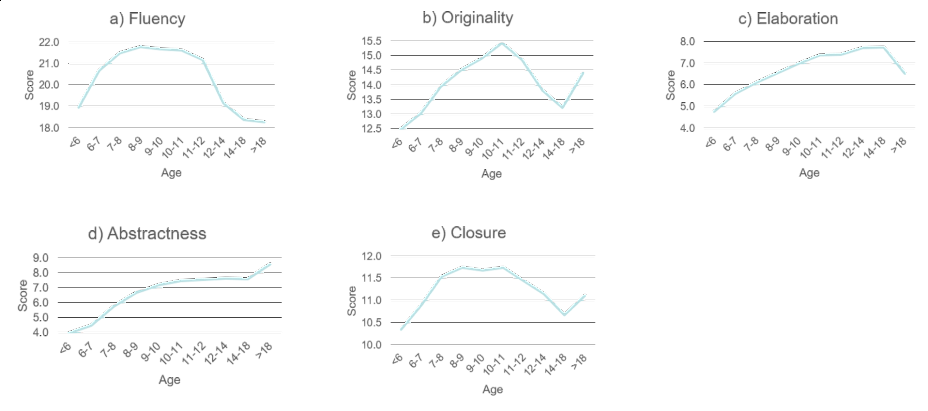There are a lot of blogs out there saying that “Schools Kill Creativity” or words to that effect. Unfortunately, few of them offer any evidence for this point of view. The few that do, generally refer to a paper by Kyung Hee Kim (1), but the results presented in this paper are far from clear cut. So, what does the paper actually say?
The paper by Kim looks at the results from a standard creativity test – the TCTT – over a period of about 40 years. In the paper, Kim focuses on the so-called “Creativity Crisis” – an apparent decrease in overall creativity scores over the previous 40 years (possibly a topic for a future blog) – but she also reports some data on the relationship between age and creativity. These figures are shown in Figure 1.
TTCT Creativity Scores vs. Age.

As can be seen, some aspects of creativity decrease from the age of about 10 but others continue to increase throughout.
Fluency: The ability to produce ideas increases up to about the age of 9 and then decreases
Originality: The ability to provide unique and unusual ideas increases until about the age of 10 and then drops.
These two results partially support the observation that divergent thinking ability decreases through school. Earlier results suggest the decrease starts at around age 5 whereas these results indicate that the decrease starts at around age 10. However, when we look at the next two aspects of creativity, we see a different pattern.
Elaboration: The ability to think in a detailed and reflective manner increases continually through school and only shows a slight drop in adulthood
Abstractness: The ability to think abstractly and to capture the essence of a block of information increases up to the age of about 11 where it levels off until adulthood, when it shows a slight increase.
These are two aspects of creativity that are key to getting value from divergent thinking. It doesn’t matter how many ideas you can come up with, or how original they are, if you cannot develop them into something that can be implemented.
The final aspect of creativity shows similar behaviour to the first two discussed.
Resistance to premature closure: The ability to be intellectually curious and open-minded increases until the age of about 9 and then decreases, with a slight increase again in adulthood.
In short, no. Or at least there is no evidence that they do. A slightly longer answer would be, divergent thinking and open-mindedness appear to increase in early school and decrease in later school while the ability to analyse ideas and information increases throughout school. It is impossible to say whether schools cause these changes or whether they are inherent in the way that children develop as they grow, but the end result remains the same – children do not lose their creativity, it merely changes and becomes more sophisticated.
The main learning point from this discussion is that creativity is not one thing. It is not simply about divergent thinking and being original. Other aspects such as being able to fill in the detail and to extract the important information are also important. The challenge for companies is not to find people who are better at divergent thinking but rather to develop ways to encourage their employees to regain their divergent thinking abilities without losing the ability to analyse and abstract information.
1. The Creativity Crisis: The Decrease in Creative Thinking Scores on the Torrance Tests of Creative Thinking. Kim, Kyung Hee. 4, 2011, Creativity Research Journal, Vol. 23, pp. 285-295.
In a training workshop a few years ago I was asked "If you could only use one ...
I shared this on LinkedIn but I thought it was worth turning it into a proper ...
I only saw the news reports of the chaos at the Oscars ceremony but, as more ...
(SCAMPER is one of the tools available in The Concept Garden web ...